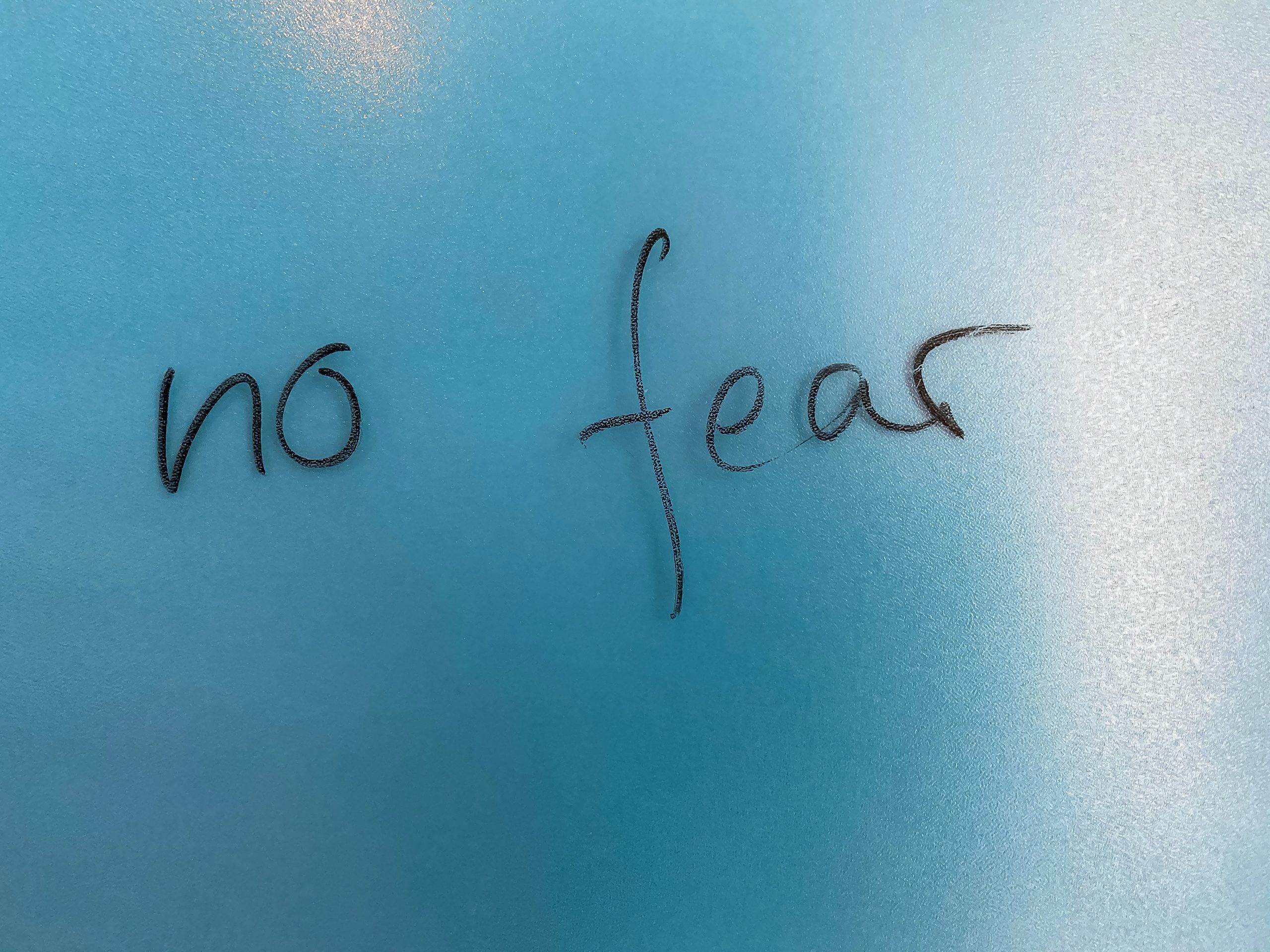Overcome Communication Apprehension by Hacking Your Body

You will never be more aware of your body than when giving a speech. Things like eye contact and gesturing, suddenly feel unnatural. The good news is there are many ways to harness your fear and turn it into power. There are many thought experiments you can do and many ways to “hack your body” to deal with the anxiety that comes from giving a speech. In this chapter, we will talk a little about thought and a lot about action.
Visualize Yourself Giving Your Speech
Visualize yourself giving your speech. Imagine yourself rising from your chair and walking towards the podium. Imagine delivering your first few words with power. Imagine your audience smiling and nodding. Imagine using your visuals effectively. Imagine thunderous applause at the end and imagine confidently walking back to your chair.
Researchers who study communication apprehension in public speaking reported that 80% of college students who used positive visualization strategies were able to reduce their level of apprehension. When students visualized giving a speech, they could reduce negative thinking and lower their communication anxiety. Not only that, but students who visualized giving their speech had better gestures and fewer “ums.”
Visualization, it is easy, it is free, and it works. Try it!
Watch Visualization and mental rehearsal (6 mins) on YouTube
Video source: Rick Sessinghaus PERFORM For Success. (2017, June 22). Visualization and mental rehearsal [Video]. YouTube. https://youtu.be/2dS63aaXjGo
Talk About Yourself in Positive Ways
It’s time to start talking nice to yourself. In the book, Communicating from the Inside Out, the authors noted the thoughts you have about yourself trigger up to 100 times more brain activity than random thoughts. In addition, when you talk out loud to yourself, your brain activity increases1,000-fold. Did you catch that? When you talk about yourself, you activate your brain in a powerful way. When you hear your own voice talk about you, you activate your brain even more, because not you have involved the listening center. It makes sense when you think about it. When I say, “I’ve got this,” I activated the part of my brain that had the thought, I activated the part of my brain associated with speech, and I activated the part of the brain associated with listening. That is a lot of brainpower given to one sentence. When you say things, good or bad, you hear yourself loud and clear. It is as if you sat in the car and cranked the volume up. When you do that, make sure the “song” you are playing to yourself is a good one.
The lesson here is this—be careful what you tell yourself because you are listening more than you know. Take charge of your thoughts and replace any negative thoughts with positive ones. Talk nice…. Your brain is listening.
Say Positive Things About Public Speaking
Your brain communicates with the firing of neurons. These neurons are like an interstate system in your brain. The more often a neural route is used, the larger it becomes. When you take the same road over and over in your thoughts, the messages transmit faster and faster. If the road is used repeatedly, then those thoughts become automatic. Think of it like the familiar road back to your house, you can drive there without even thinking about it–it’s automatic. That’s why when you practice — playing the piano, driving a car, or putting a golf ball, it becomes easier. Eventually, it is like you are on autopilot.
If you think positive thoughts over and over, then those positive thoughts become automatic. If you think negative thoughts over and over, those thoughts become automatic. That is why you have to beware of any negative thoughts you have about public speaking because if you keep thinking negative thoughts, you will make the pathway so large and strong it eventually becomes your default setting. Once those thoughts are on autopilot, they will keep playing over and over until you do something to consciously stop them.
To stop the automatic negative thoughts concerning public speaking, you need to consciously take control. You need to (1) recognize that negative thoughts are a choice and you can choose to think positive thoughts, (2) say positive things out loud and often and, (3) use visualization techniques to visualize yourself being successful at presentations. Repeat this often so these pathways become automatic.
Say “I Am Excited”
Never say, “I am nervous;” instead say, “I am excited.” When you feel nervous acknowledge it. Acknowledge that you are having a physical reaction and then take control of the interpretation. Think, “I can feel my heart beating fast. I’m nervous because I’m about to do something of consequence. It is normal for me to feel like this. I am going to interpret this feeling as excitement. I am excited.”
Give a Talk, Instead of a Speech
Instead of saying, “I have a speech to give on Monday”, say, “I am giving a talk on Monday.” A speech is fear-inducing. A talk is something simple that you do every day. Think about it, they are called TED Talks, not TED Speeches.
Exercise, Laugh and Breathe to Reduce the Effect of Cortisol
Cortisol is the stress hormone released when you are anxious, upset, or scared. Since public speaking can be a source of stress, it benefits you to work on ways to reduce the cortisol reactions. Changing how you think about stress helps, but you also need to “burn off” stress.
Exercising before and after a speech can be a powerful way to help your body reduce the effects of cortisol. A Psychology Today article, Cortisol: Why “the Stress Hormone” is Public Enemy Number One, suggests several ways to lower your cortisol levels.
- Physical activity: exercise, walk, do yoga.
- Meditation and deep breathing.
- Spend time with friends.
- Laughter.
- Listen to some of your favorite music.
Get started on your public speaking playlist today! After that, go hang out with friends. Take a walk together.
Tips from Toastmaster’s International
- Breathe out. Take slow deep breaths in and then release your breath from the bottom of your abdomen to get the maximum benefits of release and relaxation.
- Get rest. Try to get an adequate amount of sleep prior to your speech to ensure optimal mental alertness.
- Fuel your mental engine. Eat a light meal at least 20 minutes prior to your speech.
Release the Tension in Your Body
How can you make your body work for you, you ask? You can stop many of your nervous reactions by releasing the tension in your muscles.
- Roll your shoulders, loosen your arms.
- Close your eyes and notice any tight muscles. When you notice a tight muscle, first tense it– then relax it.
- Sit with your palms open and facing up on your lap.
- Consciously try to slow down your breathing.
- Make funny faces to relax your cheeks and facial muscles.
- Notice if your neck and facial muscles are tense. If they are, make a point to relax them. (See video below)
In this video, family therapist, Emma McAdam illustrates a quick way to release stress. She suggests stress is like an angry toddler that won’t be ignored and has to be acknowledged.
Watch Quick stress release: Anxiety reduction technique: Anxiety skills #19 (3 mins) on YouTube
Video source: Therapy in a Nutshell. (2018, December 18). Quick stress release: Anxiety reduction technique: Anxiety skills #19 [Video]. YouTube. https://youtu.be/lrhPTqholcc
Fake Confidence
When you get nervous, your body responds in very direct ways. Your breathing gets short and your muscles begin to tense up. Here’s the good news! Your body and your mind work in a feedback loop. Let me give you an example: If I am mad, I make a mad face and if I make a mad face, I feel mad. Now that you know there is a feedback loop, you can break into it. In the example I just gave you, I could break the mad feedback loop by smiling. If I smile long enough and add a “happy thought,” then my body tells my mind that I am happy.
The same is true with what happens when you experience communication apprehension. When you begin to feel nervous, your muscles tighten, and your breathing becomes shallow. The more your body acts nervous, the more your mind believes you are nervous. The good news is you have the power to break into the cycle. You can stop or slow down the physical reaction of nervousness.
The Facial Feedback Hypothesis states that when you make a facial expression, it can influence the emotion that you are feeling. For example, when you force yourself to smile, you begin to enjoy the moment more. The more you smile, the more you may alter your own perception of the situation. As a speaker, when you fake confidence with your body and face, you may actually begin to feel more confident. Amy Cuddy says, “Fake it until you become it.” Watch this quick video to explain more about the facial feedback effect.
Watch Facial feedback effect – Intro to Psychology (1 min) on YouTube
Video source: Udacity. (2015, February 23). Facial feedback effect – Intro to Psychology [Video]. YouTube. https://youtu.be/Lh0bL7p5eN4

Stand like Wonder Woman
Stand like Wonder Woman (or Superman) with your legs spread and your hands on your hips. Now hold that pose for two minutes. Do you feel powerful yet? Amy Cuddy, Harvard Researcher, had test subjects’ power pose (tall stance open arms, open torso) for as little as two minutes before subjecting them to a stressful job interview. Those who stood in a power pose reported feeling more confident and less nervous.
But wait, there’s more. When they asked the job interviewers what they thought of the interviewees, those conducting the interviews preferred those who had power posed before the job interviewer. The effect not only influenced the speakers, but also the listeners.
When observers view you acting confidently, they treat you like you are confident which guess what….makes you feel more confident. (Dominus, 2017).
Act confident to feel confident.
Pretend To Be Someone Else
Are you still feeling a little unsure about yourself? No worries—just pretend like you are an actor playing the part of someone who is confident. Think about a confident speaker you know. When you are mentally preparing for your speech, imagine you are that person: How would they walk, how would they talk, how would they gesture? When I make a professional presentation, I often think about my former boss who is a powerful communicator. I ask myself, how would he enter the room and shake hands? How would he walk to the podium? How would he move around during the speech? I steal his confidence to get started. When you start your speech, imagine you are that powerful person. Use their confidence going into the speech. I’m always amazed at how much confidence I gain by starting my speech as someone else. As I continue to speak that confidence that I borrowed slowly becomes mine.
Gesture to Help Release Nervous Energy
I love the movie clip from Talladega Nights where the race car driver, Ricky Bobby, is being interviewed and he keeps making his hands float up awkwardly. After struggling with his hands a while, he finally blurts out, “What do I do with my hands?” I am always amazed at how I don’t even think about my hands most days, but when I get up to give a speech, suddenly, I am aware they exist, and I have no idea what to do with them. If you are like me and like most speakers, you struggle with your hands during presentations.
Nonverbal researchers did a study where they had people describe what they did that day. When the participants told the story using their hands, they added more details to their story, spoke more fluidly, and were able to think better. Gestures seemed to help the speaker to recall information and to speak more fluidly. Did you know that even people who are blind from birth, gesture? It seems to serve the purpose of helping the speaker to think of words and maintain a flow in the speech.
Gesturing doesn’t just help the listener; it helps the speaker. But what does this mean for you? It means you are meant to gesture. It suggests that when you gesture, you will be able to think of ideas more clearly and thus speak with better fluidity. In addition, gestures can help you to release nervous energy. When you gesture, you can relieve cognitive stress, you can relieve nervous energy, and which makes you appear more confident.
Gestures also help the audience listen and understand. Studies show that speakers who gesture are seen as more persuasive, more likable, and as having more leadership potential. In a major study of the most popular TED Talks, the researchers discovered that the more gestures, the more views, and likes for the speech.
Gesturing—good for the speaker, good to relieve stress, and good for the audience!
Quick Tips with Your Hands
Make the OK sign with one hand. The act of touching your fingertips together relieves stress. This is a good trick to try when you feel a little anxious because it really is going to be “OK.”
Sweaty palms? Have an ice-cold water bottle that you hold in your hand to reduce the temperature of your hands.
Memorize Your Opening and Closing
Opening and closing a speech are the times when speakers tend to get the most nervous. For that reason, you should memorize the first few sentences and the last few sentences of your speech. When you start off powerfully, you feel powerful, and the audience expects you to be powerful. Carefully write out the first few words. Practice those over and over until you can say them with confidence and power.
When you begin to wind down your speech, your audience is preparing to clap. They don’t want to clap too soon or too late, so they are on high alert. Having a planned out closing, not only helps you own the last point, but it also gives them a definitive notion of when to clap. If you are like most of us, you might get a little extra nervous near the end. That’s why you should memorize your ending. By memorizing the closing, you are helping to relieve that tension and finish in a way that demonstrates your confidence and knowledge.

Practice until it feels comfortable
Practice at least five times
The best way to practice speaking is to practice speaking. It may sound obvious, but it is true. Make sure you practice your speech at least 5-10 times from start to finish.
Practice getting funky
After you have practiced your speech with your notes, I suggest you go someplace comfortable and practice your speech without note cards. Don’t worry if you don’t know all the details—just wing it! I like to call this “Getting funky.” Do something a little crazy like sing your speech, do your speech in a wrestler’s voice, rap your speech, or dance around while saying your speech.
Relax, have fun, get funky. This will help you associate speech with being relaxed and having fun. For “funky” speech practice, it is less important to get the words right and it is more important to relax your body, put a smile on your face, and have fun. After doing this exercise, go back and do your speech with notes and in a serious tone. You will be amazed at how much more relaxed you feel.
Practice to a live audience
It is one thing to practice to a mirror, it is another to practice to a living thing. Find a friendly face, a roommate, a friend, or a dog, and practice your speech to a live audience member. Practicing with a set of watching eyes makes a big difference.
Practice by recording yourself
Record yourself giving your speech. Sit back and watch your video recording and make notes of areas where you need to make adjustments.
Practice by visualizing your speech
Sit in your chair and imagine yourself giving your speech. Imagine your confidence as you walk to the podium. Imagine your strong opening, image the audience smiling at you. Imagine their nods of approval as you give your powerful ending.
We are what we repeatedly do.
Excellence is not an act
but a habit.
Aristotle
Write yourself encouraging notes
On top of your speech notes, put positive messages to yourself. Write “I’ve got this” in bright colors on the top of the page. Add a little cartoon character that makes you smile. Put a picture of your loved one making a funny face, a picture of your dog, a cartoon picture that makes you happy. One TED Talk speaker said she wrote on her notes, “This Matters, I’ve got this!”
I still get nervous on the first day of class, so I draw a smiley face on my notes and the phrase, “I love being a teacher.”

Breathe: Belly Breathing
One way to manage stress is to do deep breathing. Place one hand on your chest and one hand on your stomach. Take a deep breath in through your nose. Feel the breath go in. Let the breath completely fill up your lungs—inhale for 15 seconds. You should feel the hand that is on your stomach rise. Now, open your mouth and let the air out slowly over 15 seconds. Repeat this. Each time try to fill up your lungs fully. Taking as few as 3 belly breaths can increase your oxygen allowing you to relax.
Watch Deep breathing exercises for beginners (4 mins) on YouTube
Video source: Kenway, M. (2019, November 22). Deep breathing exercises for beginners [Video]. YouTube. https://youtu.be/acUZdGd_3Dg
Breathe: The nostril switch
Put your finger on the side of your nose and push the nostril closed.
Breathe in through the nose and out through your mouth.
Now, push the other nostril closed.
Breathe in through the nose and out through your mouth.
Do this until you have taken 3 breaths on each side.
Now, take 3 big breaths in through the mouth and out through the nose with both nostrils open.
This should deepen your breathing and relieve some of the stress.
Most importantly——Don’t just read about deep breathing—- DO IT!
Taking a deep breath, faking that I’m confident,
and focusing on the topic helped me manage my anxiety.
After a few seconds, I would forget about the anxiety
and really get into what I was speaking about!
Tara Johnson
Advanced Public Speaking Student, University of Arkansas
Think of Giving a Speech as a Conversation with Friends
Your goal is not to be Winston Churchill or Nelson Mandela. It’s to be you.
If you’re a scientist, be a scientist; don’t try to be an activist.
If you’re an artist, be an artist; don’t try to be an academic.
If you’re just an ordinary person, don’t try to fake some big intellectual style; just be you.
You don’t have to raise a crowd to its feet with a thunderous oration.
Conversational sharing can work just as well.
In fact, for most audiences, it’s a lot better.
If you know how to talk to a group of friends over dinner,
then you know enough to speak publicly.
― Chris J. Anderson, Curator TED Talks
Key Takeaways
- Visualize yourself being successful at speaking.
- Talk about public speaking in positive ways. Say, “I’m excited!” instead of “I’m nervous.”
- Exercise, laugh or meditate to reduce the cortisol reaction.
- Do exercises to release tension. Beware of tension and relax your muscles.
- Pretend to be confident, borrow someone else confidence if needed. Fake confidence and it will become you.
- Memorize your opening and closing.
- Write yourself positive notes.
- Practice, practice, practice.
Additional Resources
Sources of Anxiety and Ways to Overcome
- Situational — When talking to friends, we may not be nervous but if asked to say the same thing as a speech, we get nervous. The solution is to think of a presentation as a conversation rather than a performance.
- Audience –Sometimes we are nervous because of who is in the audience. The solution is to visualize your speech and the audience’s positive reaction.
- Goal –We may get anxious when we think about the goal of the speech. Often times we have a future goal that we are worried about. The solution is to focus on the moment–exercise, play a video game, do a tongue twister.
Watch No Freaking Speaking: Managing Public Speaking Anxiety (11 mins) on YouTube
Video source: Abrahams, M. (2012, September 15). No freaking speaking: Managing public speaking anxiety [Video]. YouTube. https://youtu.be/ZH5GpdMmIO8
Developing Self Confidence
Lessons from soccer coach, Dr. Ivan Joseph on how to develop self-confidence.
- Practice and keep practicing. Repetition is important for learning a skill.
- Self-talk. Be aware of the things you say to yourself.
- Get away from the people who will tear you down.
- Catch yourself doing good and record it.
Watch The Skill of Self Confidence (13 mins) on YouTube
Video source: TEDx Talks. (2012, January 13). The skill of self confidence – Dr. Ivan Joseph [Video]. YouTube. https://youtu.be/w-HYZv6HzAs
References
(1985). Visualization: A means of reducing speech anxiety. Communication Education, 34(4), 318-323. https://doi.org/10.1080/03634528509378623
Bergland, C. (2013). Cortisol: Why “the stress hormone” is public enemy number one. Psychology Today. https://www.psychologytoday.com/us/blog/the-athletes-way/201301/cortisol-why-the-stress-hormone-is-public-enemy-no-1
Brooks A. W. (2014). Get excited: reappraising pre-performance anxiety as excitement. Journal of experimental psychology. General, 143(3), 1144–1158. https://doi.org/10.1037/a0035325 Download article: https://www.apa.org/pubs/journals/releases/xge-a0035325.pdf
Bullard, B & Carroll, K. (2012). Communicating from the inside out. Kendal Hunt.
Dominus, S. (2017). When the revolution came for Amy Cuddy. New York Times Magazine. https://www.nytimes.com/2017/10/18/magazine/when-the-revolution-came-for-amy-cuddy.html
Kamath, A., Urval, R. P., & Shenoy, A. K. (2017). Effect of alternate nostril breathing exercise on experimentally induced anxiety in healthy volunteers using the simulated public speaking model: A randomized controlled pilot study. BioMed Research International. https://doi.org/10.1155/2017/2450670
Keysers, C., & Gozzola, V. (2014). Hebbian learning and predictive mirror neurons for actions, sensations, and emotions. Philosophical Transitions. Royal Society of Biological Science. 369(1644), 20130175. https://doi.org/10.1098/rstb.2013.0175
(2018). Training the butterflies to fly in formation: Cataloguing student fears about public speaking. Communication Education, 67(3) , 348-362. https://doi.org/10.1080/03634523.2018.1468915
, M.M. & . (2020). Metamorphosis of public speaking anxiety: Student fear transformation throughout the introductory communication course. Communication Studies, 71 (1), 98-111. https://doi.org/10.1080/10510974.2019.1661867
(2020). “Imagine All the People”: Imagined interactions in virtual reality when public speaking. Imagination, Cognition and Personality, 9. https://doi.org/10.1177/0276236620938310
McCroskey, J. C. (1972). The implementation of a large‐scale program of systematic desensitization for communication apprehension. Speech Teacher, 21, 255–264. https://doi.org/10.1080/03634527209377961

